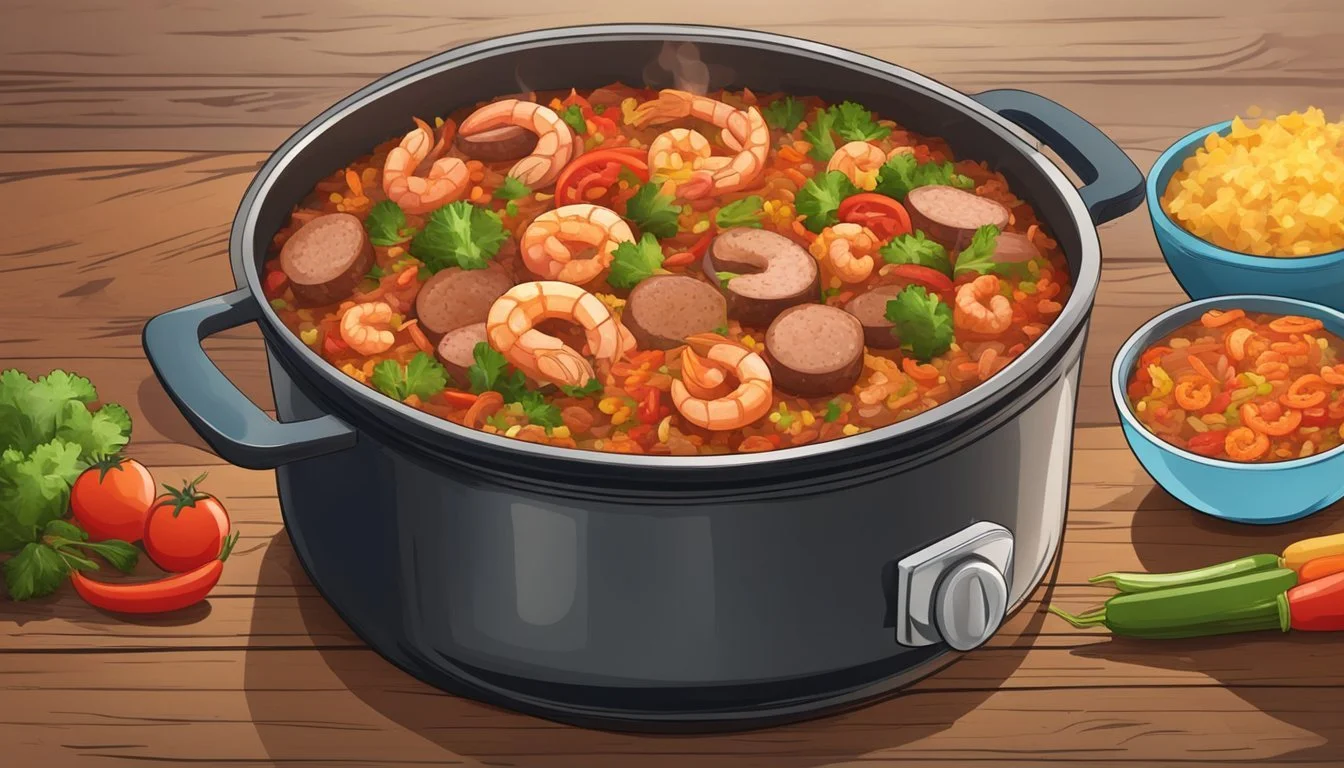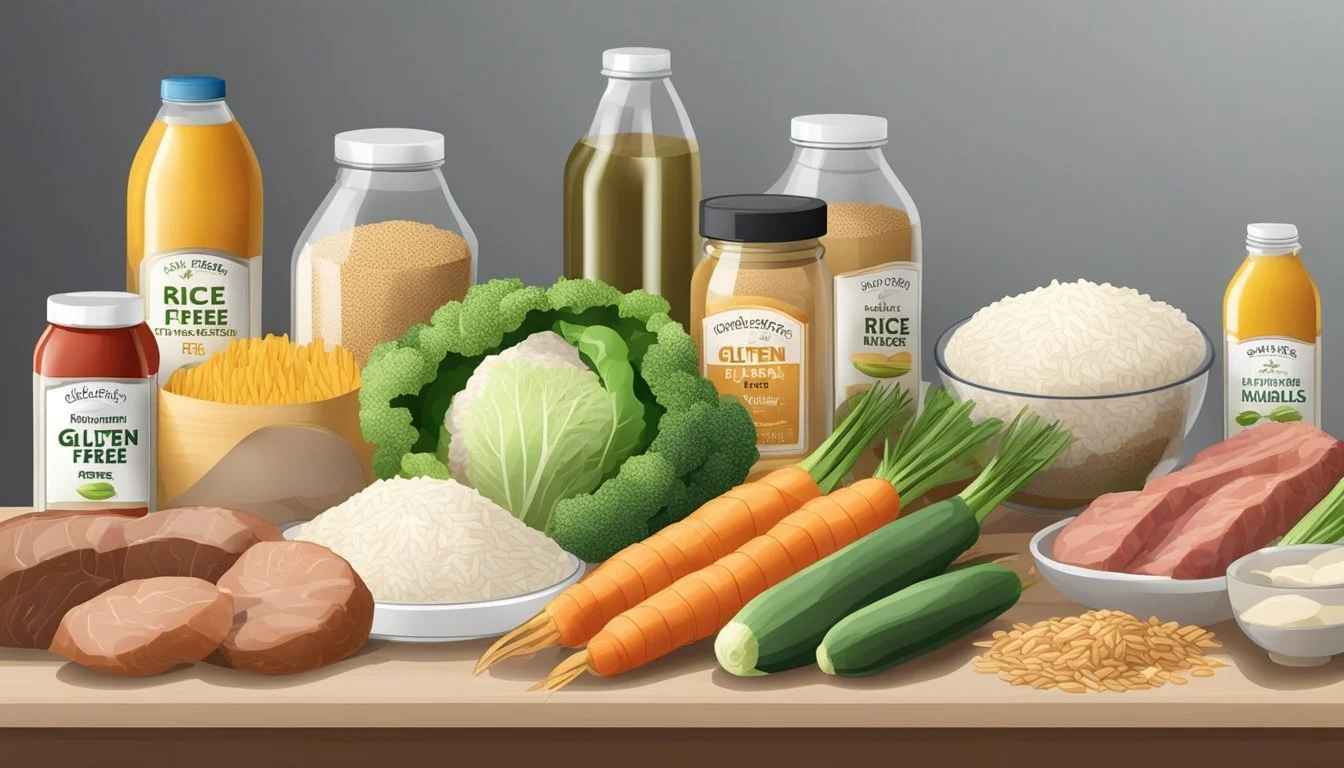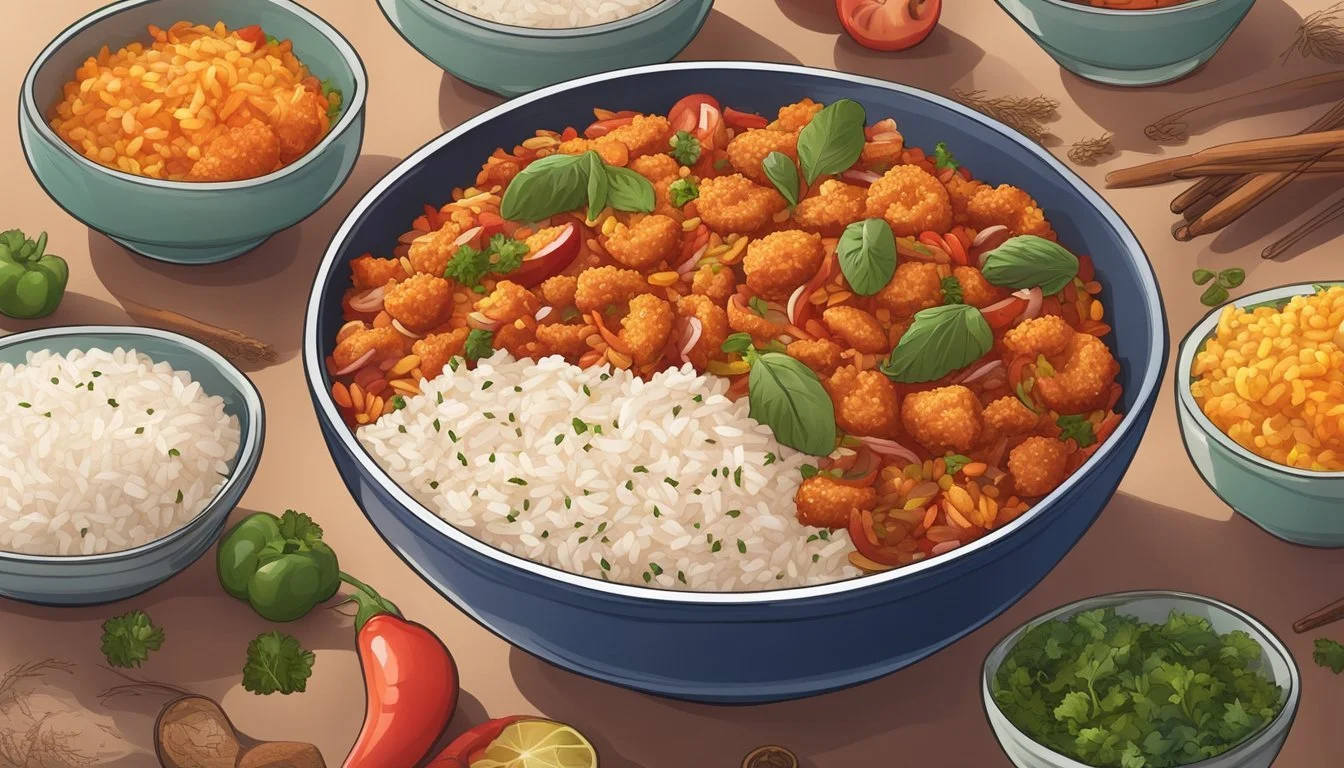Is Jambalaya Gluten-Free?
Understanding the Ingredients and Preparation
Jambalaya is a hearty, flavorful dish that's a staple in Louisiana cuisine. Traditionally consisting of meat, vegetables, and rice, its rich cajun and creole influences offer a burst of flavor in every bite. When it comes to gluten, rice is a naturally gluten-free grain, and since rice is a core component of jambalaya, the dish can be gluten-free. However, the gluten content in jambalaya largely depends on the choice of meat, vegetables, and, most importantly, the seasoning blends used, as some may contain gluten-containing ingredients or additives.
The preparation of jambalaya often includes ingredients like chicken, andouille sausage, bell peppers (What wine goes well with bell peppers?), onion, celery, and garlic. These ingredients are typically gluten-free. Nonetheless, caution is required with some sausage varieties that might include fillers or seasonings with gluten. Additionally, the thickening agents and broth used in jambalaya recipes could be sources of gluten, making it imperative for those with gluten sensitivity or celiac disease to verify the ingredients or opt for certified gluten-free options.
For those wishing to ensure a gluten-free jambalaya experience, there are numerous recipes available that use gluten-free alternatives for traditional ingredients that may contain gluten. It involves careful selection of gluten-free sausages, broths, and seasonings. Cross-contamination is another factor to consider during the cooking process, particularly in restaurants or when using shared cooking equipment. By paying attention to these details, those following a gluten-free diet can savor jambalaya without compromising their health needs or flavor expectations.
Defining Jambalaya
Jambalaya is a quintessential one-pot Louisiana Creole dish that has become synonymous with New Orleans and Cajun flavors, especially during festive occasions such as Mardi Gras.
Origins of Jambalaya
Jambalaya's roots can be traced back to multiple cultures, including African, Spanish, and French influences, which blended in Louisiana to create this unique and flavorful dish. It reflects the diverse history of New Orleans, where immigrants from Europe and West Africa assimilated their culinary traditions with local ingredients.
African Influence: Use of rice and spices.
Spanish Influence: Similarities to paella, particularly the rice-based aspect.
French Influence: Cooking techniques and incorporation of locally available ingredients.
Jambalaya Varieties
There are two primary varieties of Jambalaya that reflect the diversity of its cultural origins:
Creole Jambalaya (also known as "red jambalaya"):
It includes tomatoes, which give it the distinctive red hue.
Common in and around New Orleans.
Cajun Jambalaya:
Lacks the use of tomatoes and is typically more brownish in color.
More common in rural areas of Louisiana.
Both varieties feature a mix of chicken, sausage, and often seafood, cooked with vegetables and rice. The choice of a heavy-bottomed pot, such as a Dutch oven, is essential to evenly cook Jambalaya, allowing the Cajun flavors to develop and meld together.
Ingredients Overview
In the traditional preparation of Jambalaya, a variety of ingredients come together to create a flavorful dish. Understanding which ingredients are typically used, those that contain gluten, and how they can be substituted is crucial for those seeking a gluten-free option.
Traditional Ingredients
Jambalaya is a hearty dish with a mix of proteins and vegetables, simmered together with rice and spices. The main ingredients typically include:
Proteins: Chicken, andouille sausage, shrimp, smoked sausage, and sometimes ham
Vegetables: Onion, bell pepper, celery, diced tomatoes, okra, and garlic
Rice: Long-grain white rice is most commonly used
Spices: A savory blend including paprika, bay leaves, thyme, oregano, basil, sage, pepper, salt, cayenne, Cajun seasoning, Creole seasoning, and Tabasco
Gluten-Containing Ingredients
While Jambalaya is largely gluten-free by nature, certain ingredients can introduce gluten:
Sausage: Some andouille and smoked sausages may contain gluten as a filler or binder
Broths: Store-bought chicken or vegetable broths could have gluten ingredients or cross-contamination risks
Common Substitutes for Gluten-Free Jambalaya
Creating a gluten-free version of Jambalaya involves substituting anything that potentially contains gluten with a safe alternative:
Meat and Seafood: Ensure sausages and any pre-prepared meats are labeled gluten-free
Broth: Use homemade broths or certified gluten-free options
Spices and Seasonings: Opt for pure spices and create homemade Cajun or Creole seasonings to avoid additives
With careful consideration of these ingredients, a gluten-free Jambalaya can be easily achieved without compromising on the classic taste of this beloved Creole dish.
Preparation Techniques
The reader should understand that jambalaya can be prepared in various ways that maintain its traditional flavor while being gluten-free. The selection of cooking methods and the adjustments required for gluten-free cooking are vital for a successful dish.
Cooking Methods
One-Pot Wonder: Jambalaya is traditionally a one-pot dish, making it convenient for preparation and cleanup. Chefs often use a Dutch oven or a large pot to achieve the best results. By first sautéing vegetables like bell peppers, onions, (What wine goes well with onions?) and celery, they build a flavor base. Subsequently, proteins such as chicken and sausage are added. The entire cooking process can generally be completed within a cook time of approximately 30-60 minutes, depending on the recipe.
Slow Cooker Jambalaya: A slow cooker or crockpot is a fantastic alternative for making jambalaya with minimal supervision. The cook simply places ingredients, such as chicken, sausage, vegetables, and seasoning, into the slow cooker. This slow cooker recipe involves a longer cook time—7-8 hours on low or 3-4 hours on high—allowing flavors to meld over time.
Modifications for Gluten-Free Cooking
Gluten-free cooking requires careful ingredient selection to prevent cross-contamination. When preparing jambalaya:
Use gluten-free sausages and chicken that has been thoroughly deveined and cleaned on a cutting board reserved for gluten-free foods.
For thickening, avoid traditional roux made with wheat flour and opt for gluten-free flour or cornstarch if necessary.
Verify that all stock or broth used is certified gluten-free.
Using these techniques, cooks can confidently prepare delicious, gluten-free jambalaya while adhering to dietary restrictions.
Gluten-Free Considerations
When preparing a gluten-free jambalaya, it is imperative to understand the nature of gluten, recognize the risks of cross-contamination, and identify products that are certified gluten-free.
Understanding Gluten
Gluten is a group of proteins found in certain grains such as wheat, barley, and rye. It's what gives dough its elasticity and foods their chewy texture. Individuals with celiac disease or gluten sensitivity must avoid gluten because it can cause harmful reactions. For a jambalaya to be gluten-free, every ingredient, including the base, typically made from rice, must not contain gluten. Gluten-free jambalaya often uses grains like brown rice or long-grain white rice as they are naturally gluten-free.
Cross-Contamination Risks
Cross-contamination can occur during the harvesting, processing, or cooking stages, turning a gluten-free meal into one that's not safe for those with celiac disease. Thoroughly cleaning cooking surfaces and utensils is crucial. Separate kitchen tools and storage for gluten-free ingredients are recommended. When making gluten free dinner, especially one involving multiple ingredients like jambalaya, attention to detail is key to avoiding contamination.
Certified Gluten-Free Products
Certified gluten-free products have been independently verified to meet strict standards for gluten content. Using certified gluten-free sausages, broths, and spices can minimize the risk of accidental gluten exposure in a gluten-free jambalaya. They offer a safety assurance for those who follow a gluten-free or grain-free diet. Always look for certification labels when purchasing ingredients for a gluten-free meal.
Recipe: Gluten-Free Jambalaya
Preparing a gluten-free jambalaya can be an easy task with the right ingredients and instructions. Attention to detail with alternatives like gluten-free chicken broth and spices will ensure a flavorful and safe dish for those with gluten sensitivities.
Ingredient List
Chicken: 1 lb, diced
Andouille sausage: 12 oz, sliced (ensure it's gluten-free)
Gluten-free chicken broth: 3 cups
Bell peppers: 1 cup, diced (mix of red and green)
Green onions: 1/2 cup, chopped
Parsley: 1/4 cup, fresh and chopped
Olive oil or Avocado oil: 2 tablespoons
Garlic powder: 1 teaspoon
Onion powder: 1 teaspoon
Cayenne pepper: 1/2 teaspoon (adjust to taste)
Bay leaf: 2 leaves
White onion: 1 medium, diced
Ham: 1/2 cup, diced (optional, ensure it's gluten-free)
Sea salt: to taste
Cajun or Creole seasoning: 2 tablespoons (gluten-free)
Dried oregano: 1 teaspoon
Dried thyme: 1 teaspoon
Step-by-Step Instructions
Prepare Ingredients: Begin by dicing the chicken, chopping the bell peppers, green onions, and parsley. Slice the andouille sausage and dice the ham if including it in the recipe. Measure out all spices.
Cook Meats: In a large pot or Dutch oven, heat the olive or avocado oil over medium-high heat. Add the chicken and sausage and cook until the chicken is browned and the sausage is slightly caramelized.
Sauté Vegetables: To the pot, add the diced white onion and bell peppers, sautéing until they start to soften and become fragrant. This takes about 3-4 minutes.
Spices: Stir in garlic powder, onion powder, cayenne pepper, bay leaves, Cajun or Creole seasoning, dried oregano, and dried thyme, allowing the spices to coat the meat and vegetables evenly.
Broth and Simmer: Pour in the gluten-free chicken broth and add ham if using it. Reduce heat to low, cover, and simmer the mixture for 20-25 minutes.
Final Touches: Discard the bay leaves. Add in the chopped green onions and parsley for the last 5 minutes of cooking. Add sea salt to taste. Serve hot with a side of gluten-free rice if desired.
Additional Tips and Tricks
In this section, readers will find essential advice for serving and preserving the quality of their gluten-free Jambalaya.
Serving Suggestions
When presenting gluten-free Jambalaya, portion control is important to ensure balanced nutrition. A standard serving size can range between one to two cups, incorporating lean proteins, vegetables, and gluten-free grains to maintain a healthy balance of calories and nutritional information. For an enhanced experience:
Garnish with fresh herbs such as parsley or green onions.
Offer additional hot sauce or spices on the side for guests to customize heat levels.
Storing and Reheating
To extend the enjoyment of Jambalaya leftovers while retaining nutritional value, proper storage is key. Here is how to keep the leftovers safe and delicious:
Refrigerate: Store in an airtight container to keep for up to 3-4 days.
Freeze: For longer storage, freeze portions in airtight bags or containers. They can last for up to three months.
Thaw: Always defrost in the refrigerator overnight before reheating.
Reheat: Warm up on the stove over medium heat or in the microwave, stirring occasionally to distribute heat evenly.
Nutritional points such as calorie count and macros may shift slightly depending on reheating methods. Always ensure food is reheated to the proper internal temperature for safety.
Alternative Dietary Considerations
Jambalaya can easily cater to various dietary needs with simple substitutions. The focus within these options is on maintaining the traditional flavors while ensuring dietary compliance for those with specific restrictions.
Dairy-Free Options
Traditional jambalaya does not typically contain dairy, making it inherently friendly to a dairy-free diet. However, one should be cautious when using store-bought broth or stock which might contain dairy derivatives. For a dairy-free version, one may want to ensure the use of:
Vegetable oil instead of butter for sautéing
Chicken stock or vegetable broth that is labeled dairy-free
Meat Substitutes for Vegetarian Variations
For those seeking a vegetarian variation of jambalaya, several meat substitutes can be incorporated without compromising the dish’s savory depth:
Plant-based sausages offer a similar texture and can be seasoned to mimic traditional andouille sausage flavors.
Kale can serve as a nutritious addition that adds both color and substance to the dish.
Cultural Context
Jambalaya's place within Louisiana's culinary tradition reflects its rich cultural tapestry, blending flavors from various influences, particularly during festive seasons like Mardi Gras. The dish exemplifies the fusion of French, African, and Spanish cuisines characteristic of Creole and Cajun cooking styles.
Jambalaya in Louisiana Culture
Jambalaya holds a special position as a staple in Louisiana culture, especially in New Orleans. It's considered a quintessential Louisiana Creole dish that has evolved over centuries. Traditionally made in large quantities, it demonstrates a communal spirit ideal for gatherings and celebrations such as Mardi Gras. The Creole style of Jambalaya typically features tomatoes, which distinguish it from its Cajun counterpart and point to its European influences.
Ingredients: The Creole (or "red") Jambalaya often includes a roux, along with a mix of chicken, sausage, or seafood.
Tradition: It's a dish that brings people together, symbolizing the melting pot that New Orleans represents.
Similar Dishes Around the World
Jambalaya has parallels in other cultures, with Spain's paella being the most notable. Both dishes originate from a need to cook hearty meals for multiple people with the ingredients on hand.
Paella: Originating from Valencia, paella's closest resemblance to Jambalaya lies in the use of rice and a variety of meats and vegetables.
Gumbo: Another Louisiana classic, gumbo, often contains a roux as a base and can feature elements similar to Jambalaya but is typically a soup or stew.
Jambalaya, much like these dishes, is adaptable and brings together flavors reflecting its community's diversity, from African influences to Spanish and French culinary traditions.
Nutrition and Health Information
Traditional Jambalaya can be a nutritious meal, but its healthfulness largely depends on the ingredients used. This dish can vary widely in calorie count and macronutrient composition, based on the meats, vegetables, and particularly the type of rice selected. When considering a gluten-free variation, alternative grains or gluten-free rice products are typically used.
Caloric Breakdown
The calorie content of jambalaya can range significantly depending on the recipe, but a typical serving might contain approximately 300 to 500 calories. This variation accounts for different portion sizes and ingredient choices. Proteins such as chicken and seafood contribute to the calorie content, as do vegetables and rice—the latter being the primary source of carbohydrates in the dish.
Macronutrient Composition
Jambalaya's macronutrients include carbohydrates, proteins, and fats. The dish is carbohydrate-heavy due to the rice, but exact amounts can differ if a gluten-free rice substitute is used. Here's a basic breakdown for a standard, gluten-free serving:
Carbohydrates: Ranges from 30g to 50g, mostly from rice or a rice substitute
Proteins: Approximately 20g to 30g, depending on the quantity and type of meat
Fats: Can vary widely from 10g to 20g, influenced by the cooking oil and meats
For those following a gluten-free diet, the rice or substitute grains used should be scrutinized for any gluten content to ensure it adheres to dietary restrictions.









